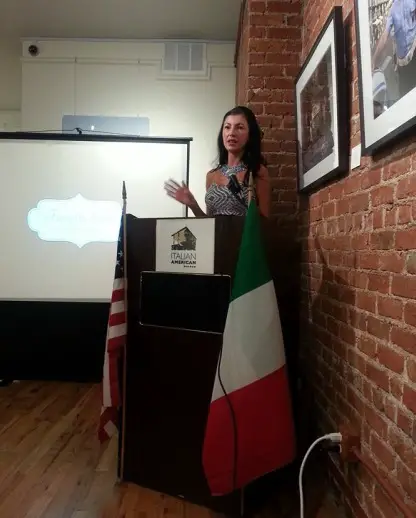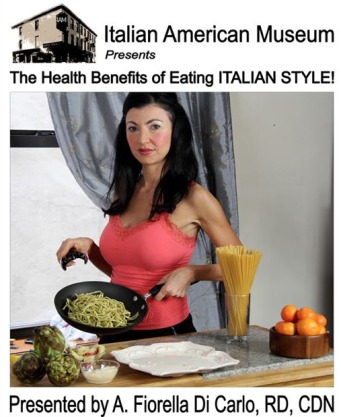Events by Fiorella DiCarlo at the Italian American Museum in Little Italy, NYC, teach the health benefits of eating Italian Style
 I recently gave a lecture at the Italian American Museum in Little Italy in NYC about the health benefits of eating Italian Style – which also included lots of tasty Italian treats for all to enjoy. As a Registered Dietitian I have known for years about the numerous studies about the health benefits of the Mediterranean diet. What I thought was equally important to present was what I see as the “Italian Style” of eating as well. With a background in psychology, I also study human behaviors as part of my work and have learned that the way we eat is just as important as what we eat.
I recently gave a lecture at the Italian American Museum in Little Italy in NYC about the health benefits of eating Italian Style – which also included lots of tasty Italian treats for all to enjoy. As a Registered Dietitian I have known for years about the numerous studies about the health benefits of the Mediterranean diet. What I thought was equally important to present was what I see as the “Italian Style” of eating as well. With a background in psychology, I also study human behaviors as part of my work and have learned that the way we eat is just as important as what we eat.
The Mediterranean diet traditionally refers to the dietary patterns of Southern Spain, Italy and Greece. It was first studied by scientist Ancel Keys in the 1940’s when he was stationed near Salerno in the region of Campania. He noticed the paradox of a culture with relatively high rates of fat intake but lower rates of cardiovascular disease. Through the years, numerous studies have shown why this is the case, as well as more medicinal benefits of this way of eating.
The diet is high in vegetables, fruits, whole grains and legumes, coupled with high quality fats such as olive oils, use of nuts in cooking and dairy. There is also a high intake of fish as their main animal protein. Fruit is eaten frequently as dessert and of course paired with wine!
So as a dietitian, I know that the fats found in nuts and olive have anti-inflammatory properties and by nature are lower in artery clogging saturated fats, which lowers risk of heart diseases. The fruits and vegetables are filled with nutrient dense vitamins and antioxidants that have anti-cancer properties. The major component of this diet is that it is high in fiber and is one of the main reasons it is so beneficial to cardiovascular health and weight maintenance. Fiber binds to fat and helps remove it from the body and this can lower cholesterol. Fiber is integral in weight loss because it keeps you fuller longer. It also provides pre-biotic properties that aids in the health of your digestive tract.
As a child, I moved from Naples to the US, and my family transferred many of our food traditions to our kitchen here. When I visited my family in Italy during the summer, I noticed they had very small refrigerators and I later found out it was because they went to market almost daily (or food peddlers came to them!) so there was barely any food to store or freeze. Food was not eaten in restaurants or brought to them by delivery men – they shopped for their food with their local producers, brought it home and cooked it with their own hands! They were more in touch with their food. Many of them had gardens; everything from lemon to peach or walnut trees, as well as chickens or pigs. To know and understand where your food comes from and to cook it is just as medicinal as the food itself.
Another habit I noticed was that they ate three meals a day and there was no snacking! That eliminated most of the processed foods that we are used to. And for dessert, most often it was some lovely fruit or cheese. In the US, Italian food became part of the fast food, super sized culture (much like other ethnic cuisines have) with gigantic portions and huge amounts of cheese and sauces that do not exist in Italy. Cheese is sprinkled sparsely on pizza and pasta is a dotted with fresh sauces in Italy.
The good news is the slow food movement, which has an emphasis on locally grown seasonal foods cooked by artisanal methods, is very trendy right now. Since we don’t all live on the Amalfi Coast, we can all still go to market once a week, buy fresh herbs and make a lovely pesto in your own kitchen – just the aroma will make you feel better!

Next Lecture will be on Aug 7th at Italian American Museum 155 Mulberry Street at 6:30 on A Taste of Sicily: Healthy Eating Italian Style!
For more videos visit: Meals for One!